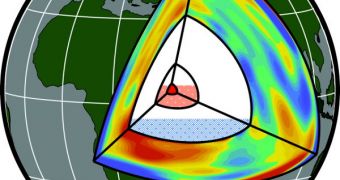British researchers at the University of Leeds propose in a new study that the planetary core is undergoing two interesting processes at the same time. According to the data the experts obtained, it could be that the core is both freezing and melting simultaneously.
Conclusions such as this, the team reveals, can be drawn from the analysis of the way in which heat circulates in the Earth's mantle – the layer of molten rock separating the outer core from the crust.
The mantle is the thickest layer inside Earth, and it is constantly stirred up by the movements of the core, and also by convection currents. All continental and oceanic tectonic plates flow atop the mantle.
At the point where they meet, one of these plates generally starts to get submerged beneath the other one, in a process called subduction. When this doesn't happen smoothly, earthquakes are triggered.
What the UL team is now proposing is that monitoring the properties of the mantle can provide clues as to what will happen to the planetary core a few million years from now. This is very important to know because it acts like a giant dynamo.
Its effects drive the magnetosphere, the layer of the upper atmosphere that shields our planet from the harmful effects of radiation released by the Sun. Details of the new study appear in the May 16 issue of the top scientific journal Nature.
For the new study, UL investigators joined forces with colleagues from the University of California in San Diego (UCSD) and the Indian Institute of Technology. “The origins of Earth's magnetic field remain a mystery to scientists,” explains Dr Jon Mound.
“We can't go and collect samples from the center of the Earth, so we have to rely on surface measurements and computer models to tell us what's happening in the core,” adds the UL expert, who was also a coauthor of the Nature paper.
“Our new model provides a fairly simple explanation to some of the measurements that have puzzled scientists for years. It suggests that the whole dynamics of the Earth's core are in some way linked to plate tectonics, which isn't at all obvious from surface observations,” the scientist continues.
“If our model is verified it's a big step towards understanding how the inner core formed, which in turn helps us understand how the core generates the Earth's magnetic field,” Mound goes on to say.
Data collected of the core until now reveal that the structure is made up of a spinning, solid ball of iron around the size of the Moon. The outer core is made up of a liquid iron-nickel alloy, which spins around the inner portion.
The most recent data indicate that the inner core may be getting cooler below the pacific Ring of Fire, where cold tectonic plates move into the mantle. Convection carries the low temperatures down.
Conversely, underneath the Atlantic Ridge, the core may be getting warmer, which means that the complexity of the processes going on inside the inner core has been vastly underestimated.
“On the one hand, we have blobs of light material being constantly released from the boundary where pure iron crystallizes. On the other hand, melting would produce a layer of dense liquid above the boundary,” says Dr Binod Sreenivasan.
“Therefore, the blobs of light elements will rise through this layer before they stir the overlying outer core. Interestingly, not all dynamo models produce heat going into the inner core,” he adds.
“So the possibility of inner core melting can also place a powerful constraint on the regime in which the Earth's dynamo operates,” concludes Sreenivasan, a coauthor of the study and an IIT expert.

 14 DAY TRIAL //
14 DAY TRIAL //